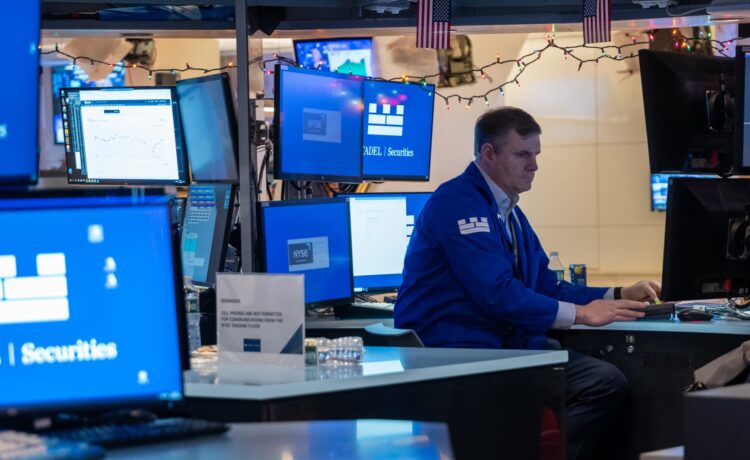The first week of 2024 is officially in the books – and with it, the end of a nine-week winning streak on Wall Street. The S & P 500 dropped about 1.5% during the holiday-shortened trading week. The Nasdaq was the worst performer this week, losing more than 3% as the Magnificent Seven stocks and other 2023 tech winners were sold. The Dow Jones Industrial Average fared better, only falling 0.6% this week, as non-tech stocks got a look. Sharp market declines on Tuesday and Wednesday also thwarted the Santa Claus rally, with the last five trading days in December and the first two in January down 1.3%. Since 1969, a decline during what’s historically been the best seven-consecutive-day period of the year has only happened 13 times. When Santa doesn’t show up on Wall Street, stocks tend to be lower later in the year. We don’t make trading decisions based on seasonal indicators, but they’re fun to point out. Looking back at this week’s trading, the decline was pretty orderly with many of the 2023 winners pulling back as the action broadened to health care, utilities, energy, and financials. Those were the only sectors up on the week. The pressure on last year’s winners was not too surprising. We even made some trims to start the new year. While the stock market was closed Monday for New Year’s Day, the week featured some key economic numbers, including Friday’s monthly employment report from the government. December nonfarm payrolls grew by a strong-than-expected 216,000. However, that strength was tempered somewhat by downward October and November revisions, which combined amounted to 71,000 fewer jobs than previously reported, and a greater magnitude than the December beat. Also working against a market in search of further disinflationary signs, average hourly earnings rose 4.1% year over year in December, above the 3.9% annual advance expected and a slight acceleration from the 4% rate of advance we saw in November. Outside of the labor market, there were conflicting readings on the manufacturing sector. The Institute for Supply Management on Wednesday released its December manufacturing report. It came in at 47.4%, indicating a continued contraction. Though a bit better than economists were expecting, it was down from November’s 46.7% reading, signaling an accelerated rate of contraction. On the other hand, factory orders, out Friday, pointed to a rebound, advancing a stronger-than-expected 2.6% in November compared to October’s 3.4% decline in October. Looking ahead to next week, it’s all about inflation and the official kick-off of the fourth quarter earnings season. Economy: The two main economic releases for next week are the consumer price index (CPI) on Thursday and the producer price index (PPI) on Friday. The CPI, a broad measure of retail inflation, carries more weight because it speaks to the prices consumers pay. That’s what the Federal Reserve cares about most as it aims to carry out its dual mandate of fostering price stability and maximizing employment. However, PPI is still important because it provides insight into input costs, which companies could choose to pass along to consumers to protect profits – and in a vicious cycle, lead to higher CPI readings down the road. Economists were looking for a 3.2% annual advance in headline CPI and a 3.8% gain in the core rate, which strips out the more volatile food and energy sectors. As for the PPI, year-over-year increases of 1.3% in headline and 2% in core are expected. Wall Street wants to see more progress in the Fed’s fight against inflation to keep central bankers in an easing state of mind. Three interest rate cuts were projected coming out of December’s Fed meeting for 2024. Earnings: Club name Wells Fargo will report results for the fourth quarter before Friday’s opening bell. We’re hoping to see the strength in the third quarter continuing in the final three months of last year. While these numbers will close the book on 2023, we’ll be looking for initial forecasts for net interest income and expenses in 2024. Expect a lot of focus to be placed on the expense guide because management still has work to bring down annual operating costs. At a higher level, we’re interested to hear management’s thoughts on the bank’s exposure to the struggling office real estate sector and what they’re doing to de-risk that part of the balance sheet. We would also welcome any additional details on increased capital requirements — along with reassurance, as we got last time, that the bank is well-positioned to hold more capital if needed while continuing to return cash to shareholders via dividends and share repurchases. We still believe it’s a matter of “when, not if” regulators lift the asset cap placed on Wells Fargo following past misdeeds. Investors, like us, will be listening carefully for any movement on that front. Monday, Jan. 8 Before the bell: Helen of Troy (HELE) After the bell: Accolade (ACCD), Jefferies Financial (JEF) Tuesday, Jan. 9 Before the bell: Albertsons (ACI) After the bell: PriceSmart (PSMT), WD-40 (WDFC) Wednesday, Jan. 10 After the bell: KB Home (KBH) Thursday, Jan. 11 8:30 a.m. ET: Consumer Price Index 8:30 a.m. ET: Initial jobless claims Before the bell: Infosys (INFY) Friday, Jan. 12 8:30 a.m. ET: Producer Price Index Before the bell: Wells Fargo (WFC) , JPMorgan (JPM), Bank of America (BAC), Bank of New York Mellon (BK), BlackRock (BLK), UnitedHealth (UNH), Delta Air Lines (DAL) (See here for a full list of the stocks in Jim Cramer’s Charitable Trust.`) As a subscriber to the CNBC Investing Club with Jim Cramer, you will receive a trade alert before Jim makes a trade. Jim waits 45 minutes after sending a trade alert before buying or selling a stock in his charitable trust’s portfolio. If Jim has talked about a stock on CNBC TV, he waits 72 hours after issuing the trade alert before executing the trade. THE ABOVE INVESTING CLUB INFORMATION IS SUBJECT TO OUR TERMS AND CONDITIONS AND PRIVACY POLICY , TOGETHER WITH OUR DISCLAIMER . NO FIDUCIARY OBLIGATION OR DUTY EXISTS, OR IS CREATED, BY VIRTUE OF YOUR RECEIPT OF ANY INFORMATION PROVIDED IN CONNECTION WITH THE INVESTING CLUB. NO SPECIFIC OUTCOME OR PROFIT IS GUARANTEED.
Traders work on the floor of the New York Stock Exchange (NYSE) on the first day back since the Christmas holiday on December 26, 2023 in New York City.
Spencer Platt | Getty Images News | Getty Images
The first week of 2024 is officially in the books – and with it, the end of a nine-week winning streak on Wall Street.
Johnwick




